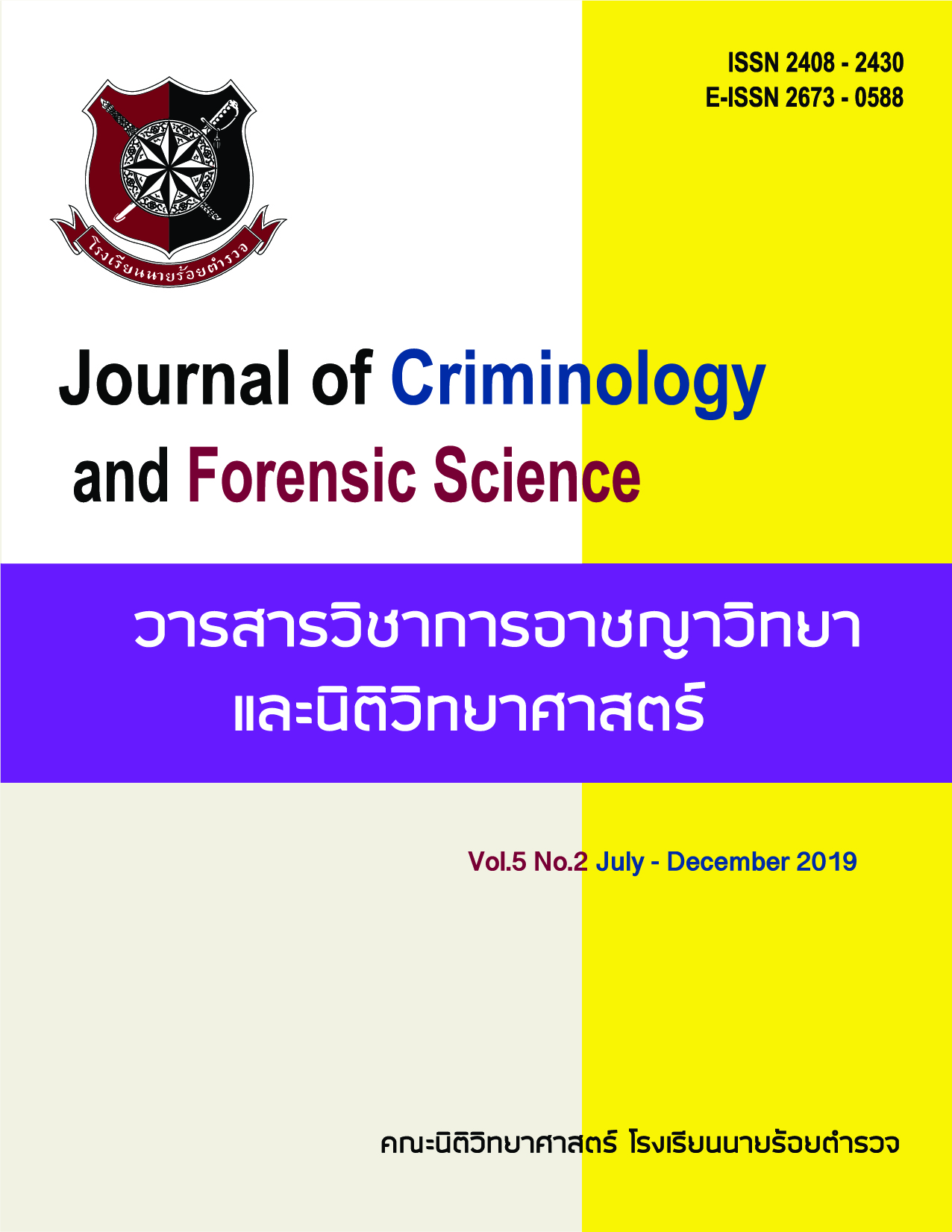การสังเคราะห์อนุภาคนาโนซิลิกอนไดออกไซด์สำหรับการตรวจหาลายนิ้วมือแฝง
Main Article Content
บทคัดย่อ
การวิจัยนี้เป็นการศึกษาการสังเคราะห์อนุภาคนาโนซิลิกอนไดออกไซด์ ด้วยกระบวนการโซลเจล รวมถึงศึกษาการดัดแปลงพื้นผิวของอนุภาคนาโนซิลิกา และการใช้สารสีย้อมเรืองแสงเพื่อนำมาประยุกต์ใช้ในการตรวจหาลายนิ้วมือแฝง โดยเริ่มต้นศึกษาการสังเคราะห์อนุภาคนาโนซิลิกอนไดออกไซด์โดยใช้ TEOS เป็นสารตั้งต้น และ NH4OH เป็นตัวเร่งปฏิกิริยา เพื่อศึกษาอัตราการไหลของ NH4OH ที่อัตรา 0.1 0.2 0.4 0.6 0.8 และ 1.0 มิลลิลิตรต่อนาที พบว่าที่อัตราการไหลของ NH4OH ที่ 0.2 มิลลิลิตรต่อนาที เป็นสภาวะที่เหมาะสมที่สุด เนื่องจากสามารถสังเคราะห์อนุภาคนาโนซิลิกอนไดออกไซด์ให้มีขนาดเล็กและมีผลผลิตได้มากกว่าร้อยละ 86.5 ในการดัดแปลงพื้นผิวอนุภาคนาโนซิลิกอนไดออกไซด์ ได้เติมสารควบคู่ไซเลนชนิด CES ศึกษาระยะเวลาในการทำปฏิกิริยา 10-60 นาที พบว่า การเติม CES เวลา 60 นาที เป็นสภาวะที่เหมาะสม เนื่องจากอนุภาคมีการกระจายตัวที่สม่ำเสมอ จากนั้นศึกษาการเติมสารสีย้อมเรืองแสงชนิด Rhodamine B เพื่อเพิ่มความคมชัดให้กับลายนิ้วมือและการนำอนุภาคนาโนซิลิกอนไดออกไซด์ที่เตรียมได้มาตรวจหาคุณภาพลายนิ้วมือแฝงบนพื้นผิววัสดุที่แตกต่างกัน 4 กลุ่มชนิด พบว่าผงอนุภาคนาโนซิลิกอนไดออกไซด์ที่ได้จากการตรวจเก็บลายนิ้วมือแฝง วิธีที่ 3 RB-CES-SNPs มีประสิทธิภาพในการตรวจหาลายนิ้วมือแฝงมากที่สุด
การวิจัยนี้สรุปได้ว่าอนุภาคนาโนซิลิกอนไดออกไซด์ที่ผ่านการดัดแปลงพื้นผิวและย้อมสารเรืองแสงมีความสามารถในการยึดเกาะของเฟสอินทรีย์บนลายนิ้วมือ และทำให้เกิดความคมชัดของลายนิ้วมือ ดังนั้นจึงมีความเป็นไปได้ที่จะสามารถนำอนุภาคนาโนซิลิกอนไดออกไซด์ที่เตรียมได้ไปประยุกต์ใช้ในการตรวจหาลายนิ้วมือแฝงต่อไป
Article Details
เนื้อหาและข้อมูลในบทความที่ลงตีพิมพ์ใน วารสารวิชาการอาชญาวิทยาและนิติวิทยาศาสตร์ โรงเรียนนายร้อยตำรวจ ถิอว่าเป็นข้อคิดเห็นและความรั้บผิดชอบของผู้เขียนบทความโดยตรงซึ่งกองบรรณาธิการวารสาร ไม่จำเป็นต้องเห็นด้วยหรือรับผิดชอบใดๆ
บทความ ข้อมูล เนื้อหา รูปภาพ ฯลฯ ที่ได้รับการตีพิมพ์ใน วารสารวิชาการอาชญาวิทยาและนิติวิทยาศาสตร์ ถือว่าเป็นลิขสิทธิ์ของวารสาร วารสารวิชาการอาชญาวิทยาและนิติวิทยาศาสตร์ หากบุคคลหรือหน่วยงานใดต้องการนำทั้งหมดหรือส่วนหนึ่งส่วนใดไปเผยแพร่ต่อหรือเพื่อกระทำการใดๆ จะต้องได้รับอนุญาตเป็นลายลักษณ์อักษรจาก วารสารวิชาการอาชญาวิทยาและนิติวิทยาศาสตร์ ก่อนเท่านั้น
เอกสารอ้างอิง
2. Chamsuwanwong, A., et al. (2009). Forensic Science 2 for Crime Investigation. Vol.6. Bangkok : G.B.P. Center (In Thai).
3. Jafarzadeh, M., Rahman, I.A., & Sipaut, C.S. (2009). Synthesis of silica nanoparticles by modified sol-gel process: the effect of mixing modes of the reactants and drying techniques. Journal of Sol-Gel Science and Technology. 50, 328-336.
4. Lee, C.N., Park, S.H., Chung, W., Kim, J.Y., & Kim, S.H. (2011). Preparation and characterization of surface modified silica nanoparticles with organo-silane compounds. Colloids and Surfaces A: Physicochemical and Engineering Aspects. 384 (1-3), 318-322.
5. Moret, S., Becue, A., & Champod, C. (2016). Functionalised silicon oxide nanoparticles for fingermark detection. Forensic Science International. 259, 10-18.
6. Rahman, I.A., Padavettan, V., Sipaut, C.S., & Ismail, J. (2006). Effect of anion electrolytes
on the formation of silica nanoparticles via the sol-gel process. Ceramics International. 32, 691-699.
7. Rahman, I.A., & Padavettan, V. (2012). Synthesis of Silica Nanoparticles by Sol-Gel:
Size-Dependent Properties, Surface Modification, and Applications in Silica-Polymer Nanocomposites-A Review. Journal of Nanomaterials. 2012, 1 – 15.
8. Songnonlek, N. (2012). Development of latent fingerprint on non-porous surface by using turmeric powder. Master of science program in forensic science Silapakorn University. (In Thai).
9. Yuan, C., Li, M., Wang, M., & Zhang, L. (2018). Cationic dye-diatomite composites: Novel dusting powders for developing latent fingerprints. Dye and Pigment. 153, 18-25.


